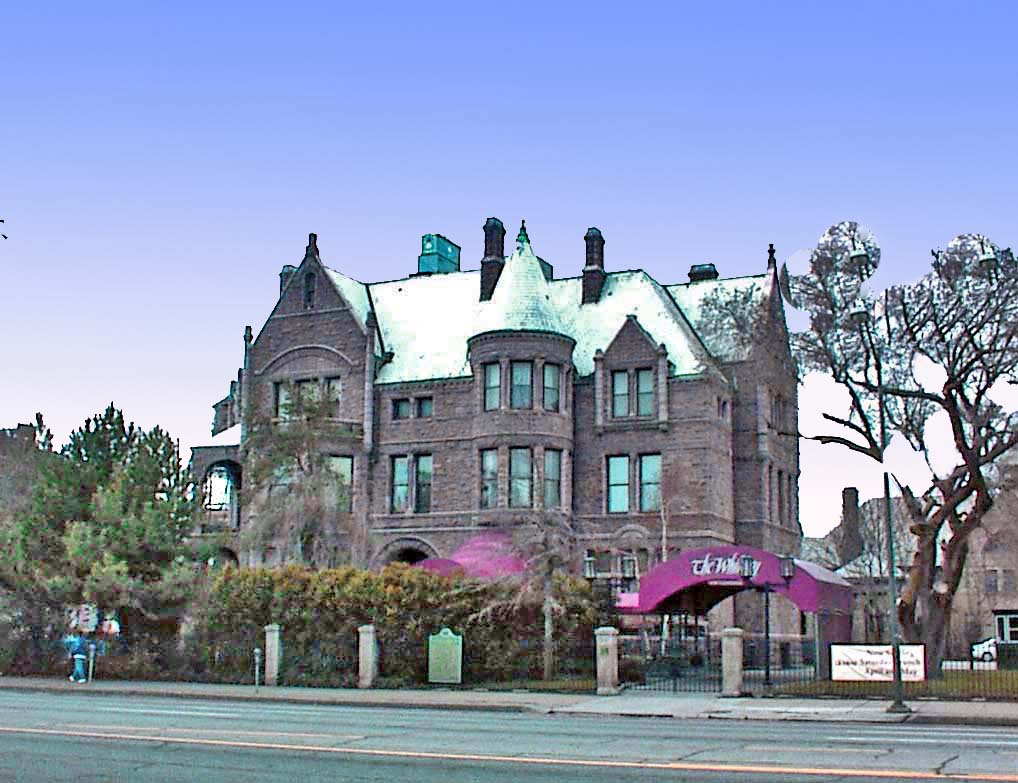
David Whitney Mansion
4421 Woodward near Detroit’s Cultural Center
David Whitney, Jr. was born in Watertown, Massachusetts in 1830. I believe that he was raised in Lowell, Massachusetts. He and his brother, Charles, migrated to Michigan in 1857. I presume that they learned much about the lumber industry from what had been occurring in Maine and New Hampshire during their youth. That is, as the nation’s population and industrial activity increased, there was a growing need for wood to build homes, ships, factories and many other things. Steel was not readily available at low cost in the United States until after the Bessemer process had been perfected. The first such Bessemer steel mill was erected in Wyandotte, Michigan in 1864 at the Eureka Iron Works. By the late 1850s, much of the most accessible and valuable timber in New England had been cut.
David Whitney made a fortune in Michigan’s timber industry. The first step was to buy Michigan forest lands at the lowest possible cost. Apparently, he could often buy such land in Michigan for as little at $2 an acre. Then there was the major task of hiring men to go into the forests and cut the trees. Next, there was the necessity of setting up mills that would process the trees. In between, was the challenge of getting the trees from the forest to the saw mills. In the mid-1850s, the only railroads in the state linked Detroit to Chicago and Pontiac and Monroe to Chicago. Sometimes trees were floated down rivers to saw mills, sometimes they were dragged across the frozen land by teams of oxen.
The Michigan timber barons were very much involved in building railroads, including many narrow gauge lines built solely for the purpose of getting trees to mills. There was also the need to get the processed lumber from saw mills to markets so many of the lumber barons, including David Whitney, invested in ship lines. I infer that David Whitney made substantial profits from his entrepreneurial skills in all aspects of the lumber business. His timber cutting involved properties in both the Upper and Lower Peninsulas of Michigan, as well as in Indiana, Ohio and Pennsylvania.
By 1890 or so, steel was gradually replacing wood as a building material. In addition, the best white pine forests of Michigan had been cut. About this time, David Whitney began investing in real estate in the city of Detroit. The Whitney’s had commissioned architect Mortimer Smith, in 1870, to design a home which was located at the corner of Woodward and Sproat. Twenty years later, he decided to build something more appropriate for his status.
This time he commissioned Detroit architect Gordon Lloyd to design what may be the most expensive home ever constructed in the city. It is a three-story Romanesque Revival built with pink jasper from South Dakota. It is a 21,000-square-foot structure that includes 52 rooms, 20 fireplaces, 218 windows, many Tiffany glass windows and a grand staircase. On the exterior you will see numerous massive arches supported by polished pink jasper columns. Forty-two of the 52 rooms are elaborately decorated in onyx, marble and hand carved woodwork. This was the first house in Detroit to have an elevator.
David Whitney died in 1900. His son continued in the real estate business in Detroit and was responsible for constructing the David Whitney Building on Grand Circus Park, a building designed by Daniel Burnham. For decades that building provided office space for hundreds of doctors but it lost its clientele after the 1960s. In 2014, about one hundred years after its construction the David Whitney Building is being renovated to provide commercial space at the lower levels while the upper floors will become a boutique hotel.
David Whitney’s widow, Flora, lived in this home until her death in 1917. Then, the Whitney family allowed the Wayne County Medical Society to use their home as an office building. In 1941 the Whitney family gave the home to the Wayne County Medical Society but that organization moved to another facility in 1956. The Visiting Nurse Association had been using the carriage house as their office building since 1929. In 1957, they purchased the home you see pictured on this page. In 1979, the Visiting Nurse Association moved away and there was speculation that the Whitney Home would be torn down. However, it was purchased by Richard Kughn. He renovated the home, and in 1986, opened the restaurant that now occupies this space.
At the time of his death in 1900, David Whitney was one of the richest men in the country. You wonder what happened to the tremendous amounts of money that some capitalists amass. We know about the Ford Foundation, the Kresge Foundation and the Sloan Foundation to mention just three of the philanthropies that derived their funds from prosperous Detroit businesses. Katherine Whitney, daughter of David Whitney, married Tracey McGregor who was something of a philanthropist himself. In 1925, Katherine Whitney and her husband established and funded the McGregor Fund. This is now a substantial local foundation spending about eight million dollars a year to improve the quality of life in the Detroit area.
Architect: Gordon Lloyd
Date of construction: 1890 to 1894
Architectural Style: Romanesque Revival
Website with additional information: http://historicdetroit.org/building/the-whitney/
Use in 2014: Restaurant
Website for restaurant: http://www.thewhitney.com/
City of Detroit Designated Historic District: Not listed
State of Michigan Registry of Historic Sites: P25,285 Listed December 10, 1971
National Register of Historic Places: Listed August 21, 1972, #72000671
Picture: Ren Farley
Description prepared: February, 2014